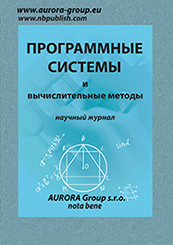Telecommunication systems and computer networks
Reference:
Shabrova, A.S., Knyazev, M.A., Kolesnikov, A.V. (2025). Dynamic RACH-Slot Allocation for Collision Minimization in NB-IoT Networks Based on Reinforcement Learning Algorithms. Software systems and computational methods, 2, 1–11. https://doi.org/10.7256/2454-0714.2025.2.73848
Abstract:
The subject of this research is the adaptive management of access to Random Access Channels (RACH) in Narrowband Internet of Things (NB-IoT) networks, which frequently face congestion due to high device density and limited channel capacity. The study focuses on the practical application of Reinforcement Learning algorithms, specifically Q-learning and Deep Q-Network (DQN), to address this issue. The authors thoroughly examine the problem of RACH overload and the resulting collisions that cause delays in data transmission and increased energy consumption in connected devices. The article analyzes the limitations and inefficiency of traditional static slot allocation methods and justifies the necessity of implementing a dynamic, learning-based approach capable of adapting to constantly changing network conditions. The research aims to significantly minimize collision rates, improve connection success rates, and reduce the overall energy consumption of NB-IoT devices. The research methodology involved the use of advanced machine learning methods, including Q-learning and DQN, together with simulation modeling conducted in the NS-3 environment, integrating a dedicated RL-agent for dynamic and intelligent RACH slot allocation. The main conclusions of the study highlight the demonstrated effectiveness of the adaptive RL-based approach for optimizing access to communication slots in NB-IoT networks. The scientific novelty lies in the development and integration of a specialized RL-agent capable of dynamically managing slot distribution based on real-time network conditions. As a result of implementing the proposed approach, the number of collisions was reduced by 74%, the number of successful connections increased by 16%, and the energy efficiency of the devices improved by 15% in comparison with traditional static methods. These results clearly demonstrate the practical applicability, and scalability of adaptive RL-based management techniques for enhancing both the performance and reliability of real-world NB-IoT networks.
Keywords:
Internet of Things, IoT, RACH, reinforcement learning, NS-3, collisions, DQN, Q-learning, Reinforcement Learning, NB-IoT
Software for innovative information technologies
Reference:
Karpovich, V.D., Gosudarev, I.B. (2025). WebAssembly performance in the Node.js environment. Software systems and computational methods, 2, 12–34. https://doi.org/10.7256/2454-0714.2025.2.74049
Abstract:
Modern runtime environments such as browsers, Node.js, and others provide developers with tools that go beyond traditional JavaScript. This study focuses on a modern approach to building web applications where components written in different programming languages can be executed and shared using WebAssembly. The subject of the research is the testing and analysis of performance benchmarks comparing JavaScript and WebAssembly modules in the Node.js runtime. The focus is on evaluating performance in computational tasks, memory interaction, data processing, and cross-language communication. The author thoroughly explores topics such as WebAssembly integration in applications, its advantages for resource-intensive tasks like image processing, and the objectivity, representativeness, and reproducibility of the tests. The work follows an applied, experimental approach. It includes performance comparisons between pure JavaScript and WebAssembly modules. Metrics like response time and system resource consumption were used to assess efficiency. The scientific novelty of this work lies in the development and theoretical grounding of testing approaches for web applications using WebAssembly. Unlike most existing studies focused on WebAssembly's performance and security in browser environments, this work emphasizes automated testing of WebAssembly modules outside the browser — a relatively unexplored area until now. A methodological approach is proposed for testing WebAssembly modules in Node.js, including principles for test structuring, integration with JavaScript components, and execution analysis. This approach takes into account the specifics of the server environment, where WebAssembly is increasingly used — particularly for high-load computational modules, cross-language logic, and secure isolated execution. The novelty also lies in defining criteria to evaluate whether certain application components are suitable for migration to WebAssembly in terms of testability, providing developers with a tool for making architectural decisions. The proposed ideas are backed by experimental results, including test case implementations for WebAssembly and JavaScript interaction scenarios.
Keywords:
compilation and interpretation, Algorithmic optimization, experimental analysis, server-side processing, technology integration, images processing, heavy processing tasks, performance optimization, JavaScript, WebAssembly
 This work is licensed under a Creative Commons Attribution-NonCommercial 4.0 International License.
This work is licensed under a Creative Commons Attribution-NonCommercial 4.0 International License.
 Eng
Eng












 © 1998 – 2025 Nota Bene. Publishing Technologies. NB-Media Ltd.
© 1998 – 2025 Nota Bene. Publishing Technologies. NB-Media Ltd.




